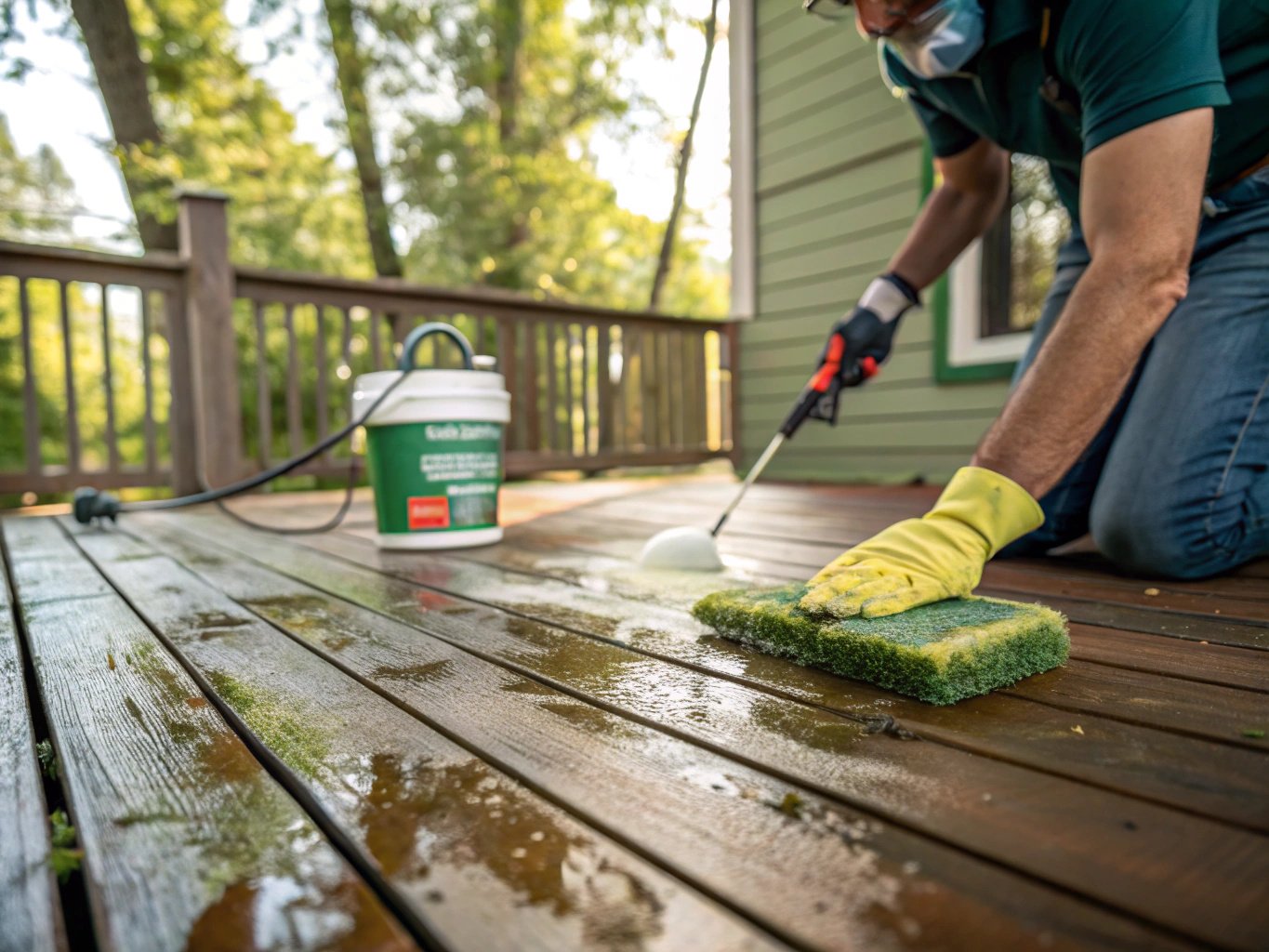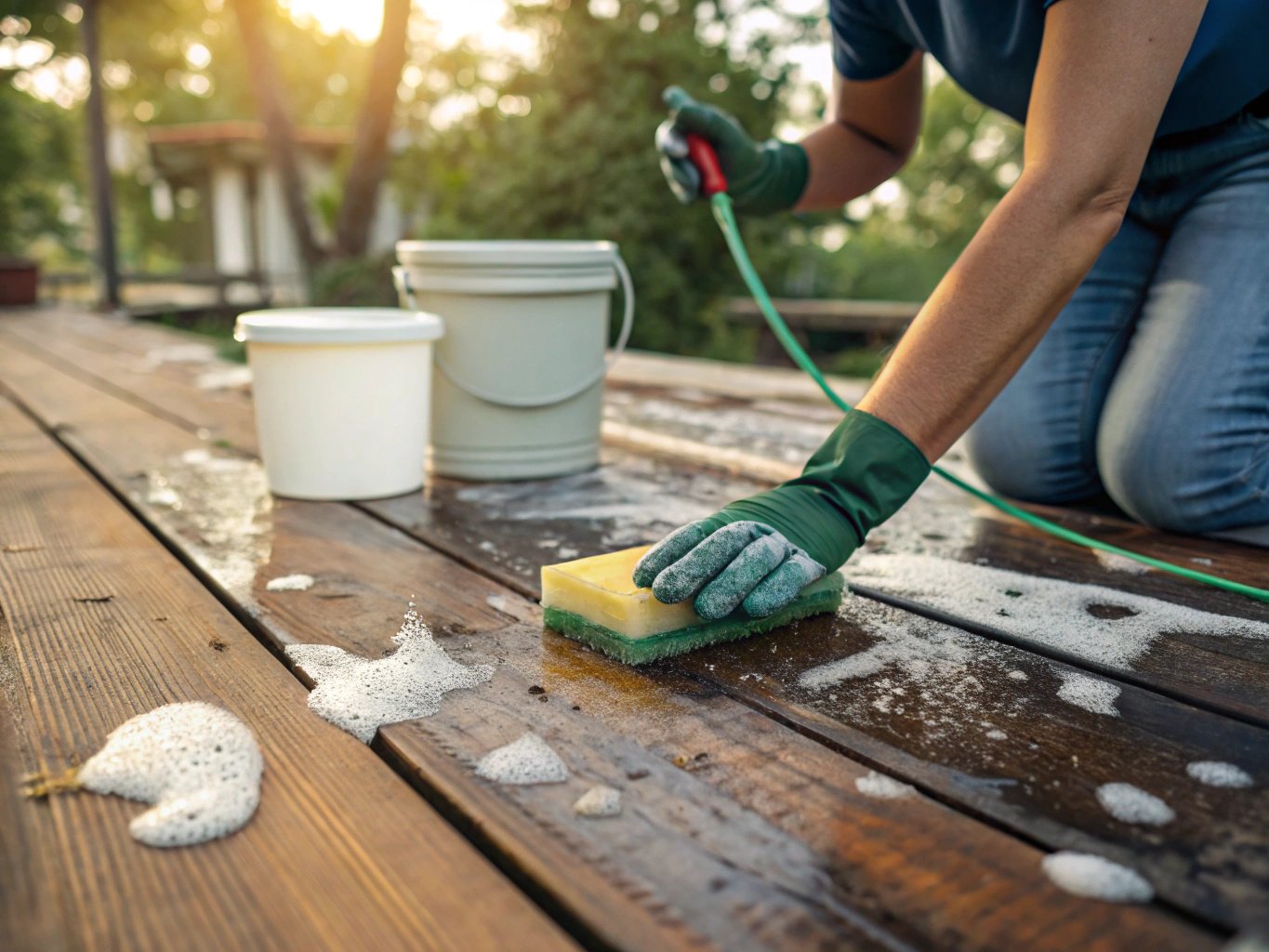
Is your wood deck covered in green algae? Removing algae not only restores the beauty of your deck but also protects it from long-term damage.
Green algae on wooden decks not only poses a safety hazard by creating slippery surfaces, but also significantly diminishes the deck’s aesthetic appeal. Explore practical and safe techniques to eliminate algae buildup and protect your deck from future growth, maintaining both its functionality and beauty
Algae growth on wood decks is a common problem, especially in shaded or damp areas. While it may seem like a simple cleaning issue, algae can cause long-term damage if not addressed properly. In this article, we’ll explore the best methods to remove green algae from your wood deck and keep it looking great all year round.
✔
Algae can cause wood to deteriorate by penetrating the surface and breaking down the fibers, which weakens the deck’s structure.
✖
While pressure washing can be effective, it can also damage the wood surface if not used carefully. It’s better to use gentler cleaning methods first, such as scrubbing with a mild detergent or using a specialized algae cleaner.
Why Green Algae Grows on Wood Decks

Green algae thrive in moist, shady environments, making wood decks the perfect breeding ground. When the weather is warm and humid, algae can start to grow quickly, especially on decks that aren’t exposed to direct sunlight. Algae spores spread easily, and once they settle on your deck, they create a slimy, green coating that can be both unsightly and slippery.
Wood is a natural material that retains moisture, making it especially susceptible to algae growth. This is why decks in shaded areas or those with poor ventilation are more likely to develop algae problems. Algae not only affects the look of your deck but can also make it slippery, creating a safety hazard.
Understanding why algae grow on your wood deck is the first step toward preventing and removing it. By addressing the underlying causes, you can reduce the chances of algae returning.
✔
Algae can indeed thrive more in shaded areas where moisture lingers longer, but they can also grow in areas with sunlight if there is enough moisture present.
✖
Wood decks are not naturally resistant to algae growth. In fact, wood is a porous material that absorbs moisture, which makes it an ideal environment for algae spores to grow.
Effective Cleaning Solutions for Green Algae

When it comes to removing green algae from a wood deck, there are several methods you can use. One of the simplest and most effective solutions is to mix a cleaning solution using common household ingredients. For mild algae problems, a solution of warm water and dish soap is usually enough to remove the growth. Simply scrub the algae with a soft-bristled brush and rinse the area thoroughly with water.
For more stubborn algae, you can try a solution of white vinegar and water. Mix one part vinegar with one part water and apply it to the affected areas. Let the solution sit for about 15 to 20 minutes, allowing it to break down the algae. Afterward, scrub with a brush and rinse off the excess solution. Vinegar is a natural, non-toxic cleaner that helps to kill algae without damaging your deck.
Another option is to use oxygen bleach, which is a powerful but gentle cleaner. Oxygen bleach is safer for wood surfaces than chlorine bleach, which can damage the wood fibers and cause discoloration. Mix the oxygen bleach with water according to the manufacturer’s instructions and apply it to the algae. Let it sit for a while, scrub the surface, and rinse well.
When cleaning your wood deck, be sure to avoid using harsh chemicals or excessive amounts of water pressure, as these can damage the wood. Always test your cleaning solution in a small, inconspicuous area before applying it to the entire deck.
✔
Vinegar is a natural solution that helps kill algae without causing harm to the deck’s wood or the surrounding environment.
❌
Chlorine bleach can weaken the wood and cause discoloration, making it unsuitable for cleaning wood surfaces.
Preventing Future Algae Growth on Your Deck
Once you’ve cleaned your deck and removed the green algae, it’s important to take steps to prevent it from coming back. Regular maintenance is key to keeping algae at bay. One way to do this is by ensuring your deck is properly sealed. Sealing your deck helps protect the wood from moisture, reducing the conditions that allow algae to grow.
In addition to sealing, keep the area around your deck well-ventilated and dry. Trim back trees or shrubs that block sunlight and prevent airflow around the deck. Good drainage is also essential. If water pools on your deck, it provides an ideal environment for algae to thrive. Make sure your deck is angled slightly to encourage proper water runoff.
Regularly cleaning your deck, even if it’s just sweeping away dirt and debris, can also help prevent algae growth. You don’t need to perform deep cleaning every time, but regular upkeep will prevent moisture buildup and make it harder for algae to take root.
✔
Sealing the deck helps protect the wood from moisture, reducing the likelihood of algae growth by limiting the conditions algae thrive in.
❌
While trimming trees can help improve sunlight exposure, it is not a complete solution. Algae can still grow in moist conditions even if some sunlight reaches the deck.
How to Maintain Your Deck Year-Round
Maintaining your wood deck year-round requires more than just cleaning it. In the fall, consider washing the deck to remove fallen leaves and debris before the wet season starts. During the winter, protect the deck from snow and ice accumulation, as frozen moisture can cause damage to the wood. In the spring, inspect the deck for any algae growth and clean it as necessary.
If you live in a region with a lot of rain or humidity, be extra diligent about keeping your deck dry. You may also want to consider applying a wood preservative or anti-fungal treatment to discourage future algae growth.
For more detailed tips on deck maintenance, you can visit this helpful guide.
❌
Regular maintenance throughout the year is necessary to prevent algae from growing back and to protect the wood from environmental damage.
✔
Wood preservatives, especially those with anti-fungal properties, can help reduce the likelihood of algae and mold growth on your deck.
Conclusion
Removing green algae from your wood deck is essential for both aesthetic and safety reasons. By using simple, natural cleaning solutions like vinegar or oxygen bleach, you can effectively eliminate algae without damaging your deck. Additionally, regular maintenance, including sealing and proper ventilation, will help prevent algae from returning. With these methods, your wood deck will stay beautiful and safe for years to come.
For further information on wood deck care, check out this detailed article.
